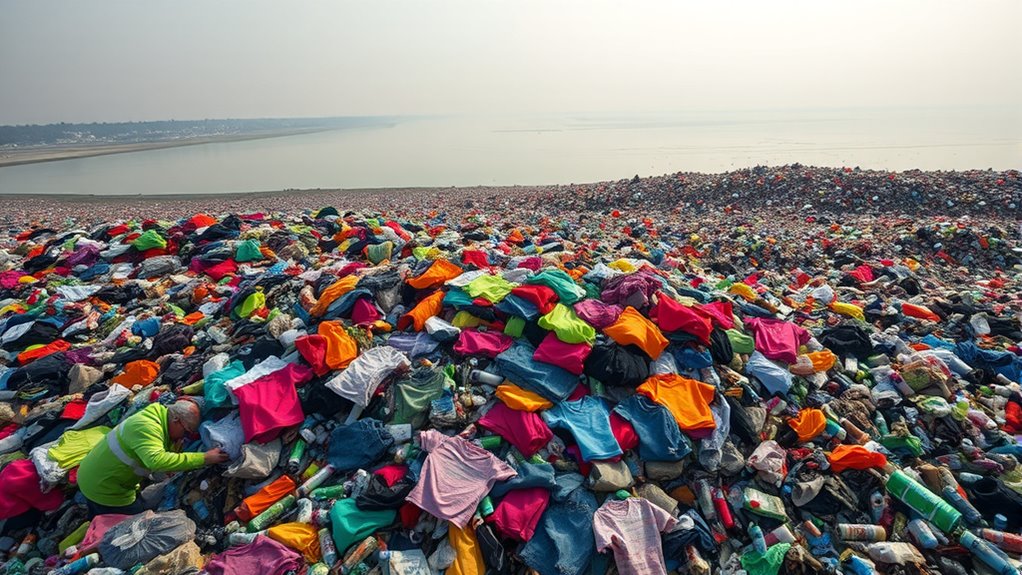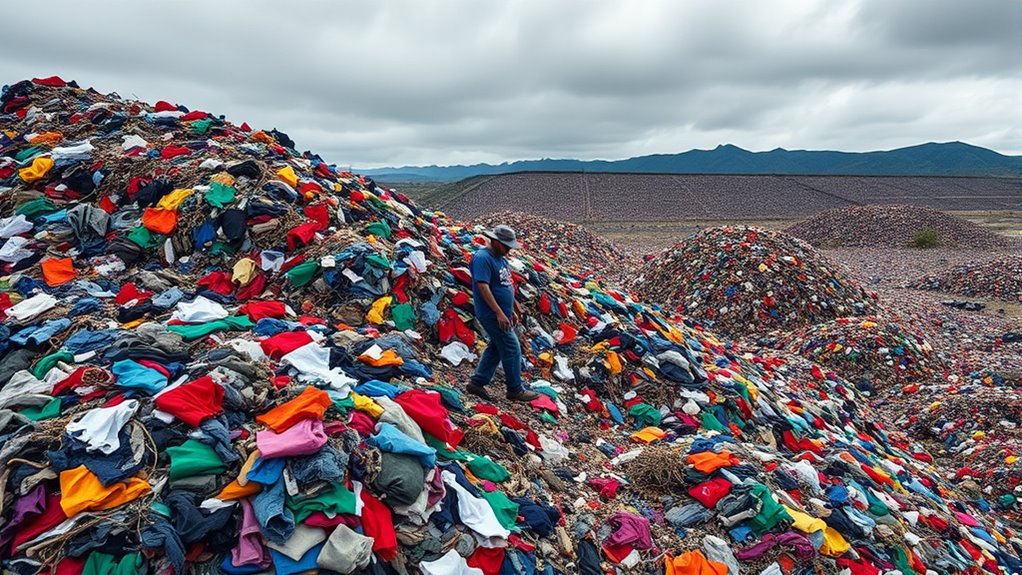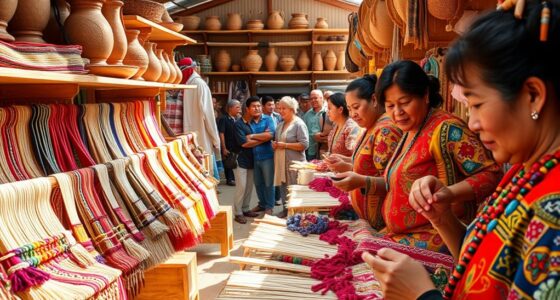Fast fashion harms the environment by fueling pollution, wasting resources, and creating mountains of waste due to quick production and cheap, disposable clothes. To reduce its impact, you can choose brands that prioritize sustainable materials like organic cotton or recycled fibers. Support ethical manufacturing that cares for workers and the planet, buy fewer high-quality pieces, and stay informed about eco-friendly practices. Keep exploring ways to make a positive difference for a greener fashion industry.
Key Takeaways
- Fast fashion’s rapid production and low prices lead to excessive waste, pollution, and resource depletion.
- Choosing sustainable materials like organic cotton and recycled fibers reduces environmental harm.
- Ethical manufacturing practices, including fair wages and eco-friendly processes, minimize the industry’s ecological footprint.
- Buying fewer, higher-quality garments extends clothing longevity and decreases overall waste.
- Supporting transparent brands with eco-conscious initiatives encourages industry-wide shift toward sustainability.

Have you ever wondered how your quick-to-buy, inexpensive clothing choices affect the planet? Every time you pick up a trendy T-shirt or a pair of fast-fashion jeans, you’re part of a system that has significant environmental consequences. Fast fashion thrives on rapid production cycles and low prices, but it often does so at the expense of the environment. One way to make a difference is by paying attention to the materials used in your clothing. Choosing garments made from sustainable materials can drastically cut down on pollution and resource depletion. Sustainable materials like organic cotton, hemp, and recycled fibers reduce the need for harmful pesticides, water, and energy. By supporting brands that prioritize these options, you help push the industry toward more eco-friendly practices. Additionally, ethical manufacturing plays a vital role in minimizing environmental harm. Ethical manufacturing ensures that workers are paid fair wages and work in safe conditions, but it also emphasizes environmentally conscious production processes. Brands that commit to ethical manufacturing often implement cleaner, more sustainable practices—like reducing water and energy use or avoiding toxic dyes—that lessen their overall ecological footprint. When you actively seek out brands that prioritize sustainable materials and ethical manufacturing, you’re voting with your wallet for a greener future. This choice encourages companies to adopt eco-friendly innovations and transparent supply chains, which ultimately reduces waste and pollution. It also promotes a shift away from the disposable mindset that fast fashion fosters. Instead of impulsively buying multiple cheap items, you can invest in fewer, higher-quality pieces made with sustainability in mind. These items last longer, reducing the cycle of constant consumption and disposal. Furthermore, educating yourself about the brands you support helps you make informed decisions. Look for certifications or labels that guarantee sustainable practices, and research their manufacturing processes. This not only impacts the environment but also supports fair labor practices worldwide. Staying informed about fast fashion’s environmental impact allows consumers to make more responsible choices and advocate for industry change. While it might seem like a small step, your conscious choices can contribute to a larger movement toward a more sustainable fashion industry. By prioritizing sustainable materials and ethical manufacturing, you help combat pollution, conserve resources, and promote social responsibility. Over time, your individual actions can influence brands to rethink their production methods, making eco-friendly fashion more accessible and mainstream. Every purchase becomes an opportunity to support a healthier planet and a fairer industry. So, next time you shop, consider these factors and choose wisely—your choices can make a meaningful difference in reducing fast fashion’s environmental impact.
Frequently Asked Questions
How Does Fast Fashion Affect Water Resources Globally?
Fast fashion severely impacts water resources globally by causing resource depletion and water pollution. When you buy fast fashion, you contribute to high water demand for production processes, which depletes local water supplies. Additionally, the dyes and chemicals used often pollute water sources, harming ecosystems and communities. Your choices can help reduce this impact by opting for sustainable brands and reducing consumption, supporting cleaner water resources worldwide.
What Are the Social Implications of Fast Fashion Production?
You might not realize it, but fast fashion production often leads to social issues like labor exploitation, where workers face poor conditions and low wages. It also promotes cultural homogenization, erasing local traditions as global brands standardize styles. By supporting fast fashion, you inadvertently contribute to these problems, so choosing ethical brands helps protect workers’ rights and preserve cultural diversity. Your choices can make a meaningful difference.
Can Biodegradable Fabrics Mitigate Fast Fashion Waste?
Biodegradable fabrics, like organic cotton or hemp, can definitely help reduce fast fashion waste. For example, a brand switching to eco-friendly fibers and biodegradable textiles saw their landfill contributions drop markedly. These materials decompose naturally, cutting down landfill accumulation and environmental harm. Incorporating biodegradable fabrics into your wardrobe not only supports sustainability but also encourages the fashion industry to adopt more eco-conscious practices.
How Does Fast Fashion Influence Global Carbon Emissions?
Fast fashion substantially increases your carbon footprint by encouraging rapid production and consumption of cheap clothing. As you follow fast fashion trends, more garments are made quickly, often using energy-intensive processes that emit greenhouse gases. Your choices contribute to higher global carbon emissions, amplifying climate change. By staying mindful of these trends and opting for sustainable options, you can help reduce the environmental impact and lessen your contribution to global carbon emissions.
What Role Do Consumers Play in Reducing Fast Fashion Impact?
You can make a difference by becoming more conscious of your shopping habits and increasing your awareness about fast fashion’s impact. When you choose quality over quantity, avoid impulsive buys, and support sustainable brands, you reduce waste and demand for fast fashion. Coincidentally, your mindful decisions not only lessen your environmental footprint but also encourage others to follow suit, creating a ripple effect toward a more sustainable industry.
Conclusion
Imagine your wardrobe as a garden, where every new trend is a seed. If you plant too many, weeds take over, choking out the beauty. Fast fashion is like that relentless weed—quick to grow and hard to remove. By choosing quality over quantity and supporting sustainable brands, you can stop the spread. Together, we can clear the weeds and let our planet flourish, proving that small actions can truly make a big difference.









